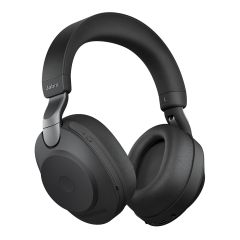The ABCs of ANC: Exploring the Different Types of Active Noise Cancellation

Active Noise Cancellation (ANC) has become the talk of the town when it comes to headphones and headsets, and for good reason! These cutting-edge devices boast an unparalleled ability to whisk away unwanted noise and distractions, creating a serene listening experience like no other. In a previous blog post, we delved into the differences between Active Noise Cancelling and Passive Noise Cancelling headsets and their unique features and benefits.
But did you know that Active Noise Cancellation (ANC) comes in more than one flavour? That's right – there are three different types of ANC technologies, each with its own set of advantages and characteristics. This adds a whole new layer of excitement and possibilities to Active Noise Cancellation!
Let's go on a journey together through the various ANC types, exploring their unique strengths and applications. From feedforward and feedback ANC setups to the impressive hybrid approach, we'll be your guide in navigating the exciting (and often confusing!) world of Active Noise Cancellation technology. But before we go into the different types of ANC, it's important to understand how it works. So let's do a super quick primer on how ANC works to cancel noise.
Post Contents [hide]
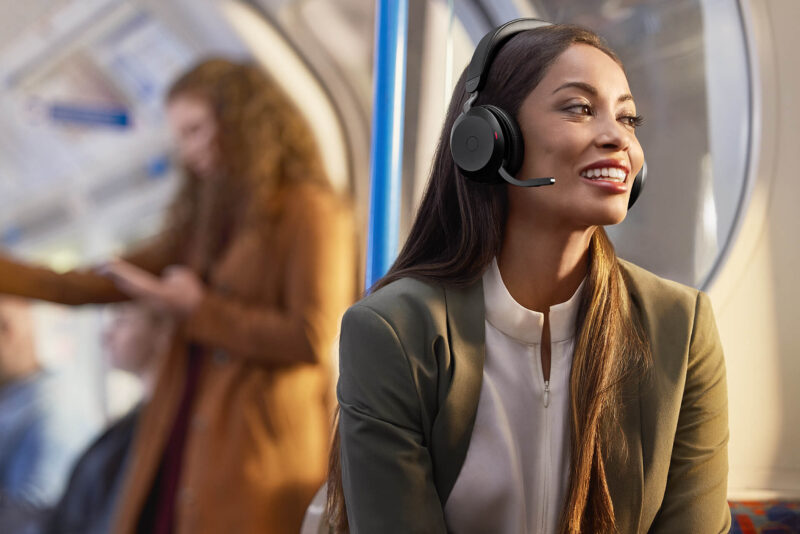
How does Active Noise Cancellation Work?
In the fascinating world of Active Noise Cancelling (ANC) headsets, small yet mighty microphones take centre stage. Positioned on the outside of the headphones, these microphones serve as keen listeners, attentively capturing the background noise around you. Their mission? To skilfully devise a plan to cancel out those unwanted distractions.
Once the microphones gather the background audio, they work their magic by creating an exact replica of it and then cleverly flipping its phase by 180 degrees. This phase reversal essentially turns the sound waves upside down. The result? A truly heavenly phenomenon – the sound of silence! And the best part? This entire process happens in a blink of an eye, so swiftly that your ears never even perceive the presence of the background noise.
For us audio geeks, this remarkable technique is called phase cancellation. It hinges on the notion of reversing the peaks and valleys of two identical audio waves. An intriguing contrast emerges when you imagine what would happen if those waves played in sync without inverting their phase – the resulting sound would be louder, a stark contrast to our quest for serene silence. However, when these identical sound waves play out of phase with each other, the magic unfolds, and the sound is marvellously cancelled out.
As for Passive Noise Cancellation (PNC), this doesn't rely on tiny microphones or any fancy audio wizardry. Instead PNC refers to the design of a pair of headphones that naturally form a seal around or inside the ear and passively isolate noise. You can have an ANC headset that also features a design that passively blocks out noise, so you can most certainly have both types of noise cancellation in a headset.
What are the different types of Active Noise Cancellation?
Now for Active Noise Cancellation, which relies on microphones listening to outside noise and phase inverting it to make it disappear before it reaches your ears, there are different microphone and speaker configurations that make a difference in how noise is cancelled. There are three different types of ANC: feedforward, feedback, and hybrid. Each approach has its unique strengths and quirks, and understanding them will help you choose the perfect noise-cancelling companion for your audio adventures. So, get ready to discover the wonders of these ANC techniques and find out how they can elevate your listening experience to a whole new level!
Feedforward Active Noise Cancellation
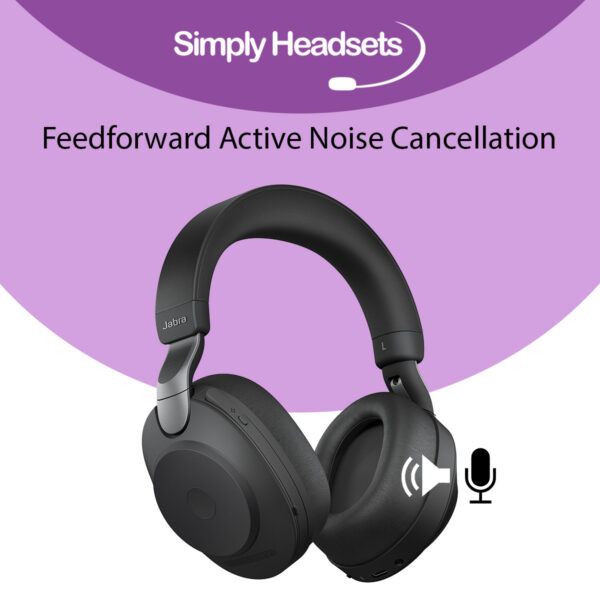
With Feedforward Active Noise Cancellation, a tiny microphone sits outside your headset's ear cup, waiting to hear any unwanted noise even before you do.
Here's how it works: when the microphone detects noise, the ANC magic begins. It processes the noise and quickly creates its secret weapon, the anti-noise. This special anti-noise signal is then sent to the headset speaker, and voilà - the unwanted noise is silenced!
This cool feedforward setup is commonly found in communication headsets like Bluetooth ones because it's really good at blocking out noise across a wide range of frequencies, up to 3kHz! That's the range where human voices usually hang out, making it perfect for crystal-clear phone calls.
Why it's so awesome: Since the mic hears the noise early on, it has more time to react and create the anti-noise. This means it's excellent at tackling higher-frequency noises, like those pesky ones around 1-2 kHz.
But, wait, there's a little downside: Since the setup doesn't get to hear the anti-noise it makes, it can't self-correct. So, if it's not positioned perfectly or if the noise comes from a funny angle, the setup might goof up and accidentally amplify the noise at some frequencies!
Also, it's got its limits. Feedforward ANC works best in a narrower range of frequencies, so it may not be as effective at reducing noise at lower frequencies.
Oh, and one more thing - the mic being outside makes it more sensitive to wind noise. So, on windy days, it might have a tough time distinguishing between the wind and noise you want to cancel.
So there you have it, the super heroic feedforward ANC - great at combating certain noises but with a few quirks of its own. Keep rocking those noise-free tunes and calls!
Feedback Active Noise Cancellation
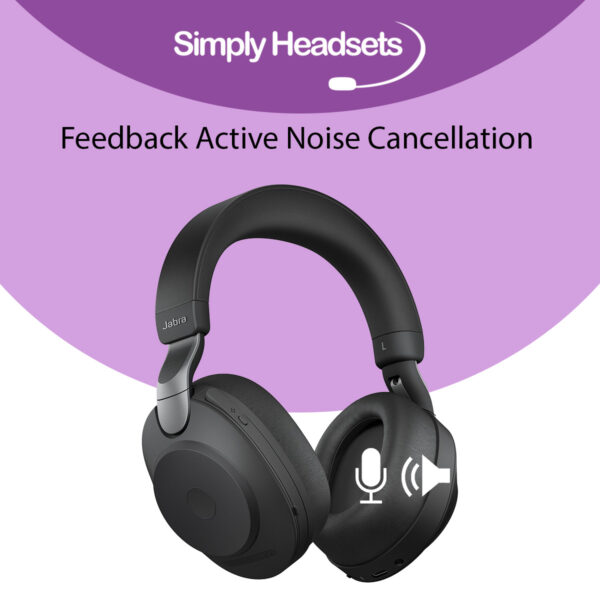
With Feedback Active Noise Cancellation (ANC), the microphone hangs out inside the ear cup, just in front of the speaker, capturing the same sound you hear.
Now, here's the secret sauce! Feedback ANC has a smart trick up its sleeve to overcome that pesky wind noise issue. The microphones are cleverly placed inside the ear capsule, making the headset wind-resistant, so no more annoying whooshing sounds.
One of the coolest things about feedback systems is their ability to automatically adjust for little leaks. Unlike feedforward systems, which require a good seal around your ears, feedback systems can handle some wiggle room without compromising ANC performance. So, they fit like a glove and give you consistent ANC power.
But let's get to the nitty-gritty – the differences between the two ANC superheroes! Feedback systems usually excel at tackling low-frequency noises (<100Hz), but they don't quite match the broad bandwidth of feedforward systems. Feed-forward systems, on the other hand, shine in the peak performance arena (up to 25dB) with a cone-shaped characteristic. It's like comparing two unique musical styles – each has its strengths.
Why it's fantastic: Feedback ANC is like a quick learner – it adapts to variations and can correct signals if needed, giving you a tailor-made ANC experience. Plus, it works on a wider range of frequencies. And here's the magic – even if your headset doesn't sit perfectly or fully covers your ears, feedback ANC has your back, at least to some extent.
But hold up, there's a drawback: Feedback ANC might not be as skilled at handling higher-frequency sounds, so it's not as effective as feedforward ANC in the 1–2 kHz range. And if the designers don't plan things carefully, there's a risk of feedback noise – that annoying high-pitched shrill you get when a microphone is too close to a loudspeaker.
Another thing to keep in mind is that feedback ANC treats both the incoming music and noise signals. Sometimes, it accidentally filters out that sweet, low-frequency bass line in your favourite songs. Oops, music lovers beware!
To tackle the low-frequency loss challenge, designers get creative with solutions like subtraction circuits or EQ circuits on the music input. It's a bit of a juggling act, but they work hard to bring you the best possible ANC experience.
So there you have it – Feedback ANC, the dynamic ANC hero that brings you a tailor-made noise-cancelling journey. With its quirks and perks, it's ready to take on the noise and give you a harmonious audio haven!
Hybrid Active Noise Cancellation
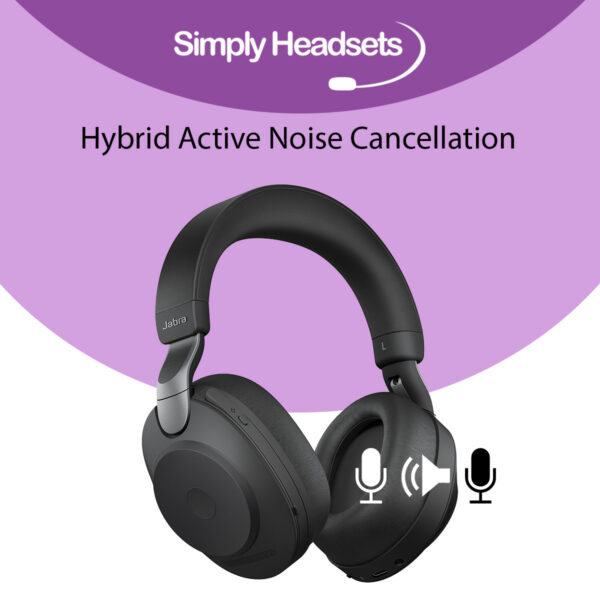
Hybrid Active Noise Cancellation is like having the best of both worlds, as it cleverly mixes feedforward and feedback ANC by placing microphones both inside and outside the ear cup.
Now, let's break down the magic! This technology brings together the strengths of both systems, creating a one-of-a-kind ANC experience. It reaches peak ANC performance levels (>30dB) with the widest range of frequencies. It's like a perfect dance – one system makes up for what the other lacks, and vice versa. The result? Superior ANC power from 20Hz up to 3kHz, something you can't achieve with a standalone feedforward or feedback system.
Sure, this hybrid hero is the most expensive option (yup, two microphones per channel!) and requires serious production expertise. But hey, it's worth every cent! With a hybrid headset, you'll stand out from the crowd of ordinary ANC headsets. No wonder the trend for new high-end ANC headsets is leaning toward "Hybrid"!
Why it's awesome: Hybrid ANC brings you all the benefits with almost none of the drawbacks. It has a broad frequency range, adaptability, and error correction powers. Plus, it's not as fussy about how you wear the headset.
But, there's a catch! With great power comes...well, higher costs. Because hybrid ANC uses both approaches and two microphones, it's, you guessed it, more expensive. And it takes some serious know-how to get it just right. To counteract any unwanted "white noise," high-quality microphones are essential, adding to the overall cost.
So, while the hybrid solution is a top-notch choice, it's not the only factor to consider. Creating an outstanding ANC headset involves other key elements too – like the headset's physical design, passive noise cancellation, music quality, and more. It's all about finding the perfect balance for your ultimate audio experience!
NB: the headset in the images above is just for demonstration purposes to highlight the mic and speaker placement in the three different types of Active Noise Cancellation (ANC). The headset in the image is a Jabra Evolve2 85, which is a premium Hybrid Active Noise Cancelling headset. Grab a pair today by clicking the product link below!

How do the different types of Active Noise Cancellation compare?
| Type of ANC | Description | Advantages | Drawbacks |
| Passive Noise Cancellation | Relies on the acoustic design of ear cups or earbuds to physically block outside noise. More affordable, doesn't require batteries. May not provide the same level of noise cancellation as active technologies. | - Budget-friendly - No need for batteries | - May not offer the same level of noise cancellation as active technologies |
| Feedforward Active Noise Cancellation | Uses external microphones on the ear cups to detect and process external sounds before reaching the ears. Effective at cancelling mid-frequency sounds. Might struggle with wind noise. | - Excellent at reducing background chatter - Effective for constant noises | - May not handle wind noise as well - Slightly less effective for outdoor use |
| Feedback Active Noise Cancellation | Places the microphone inside the ear cup for superior wind noise cancellation. Adapts to variations, ensuring stable performance. May not deliver the same bass quality as other ANC types. | - Superior wind noise cancellation - Stable and consistent performance | - May not provide the same bass quality as other ANC types |
| Hybrid Active Noise Cancellation | Combines feedforward and feedback technologies by using both external and internal microphones. Offers excellent noise cancellation across a wide range of frequencies. More expensive but versatile. | - Outstanding noise cancellation - Versatile across various frequencies | - Higher price point compared to other ANC types |
Passive Noise Cancellation, as the name suggests, doesn't rely on any microphones or power. Instead, it uses the acoustic design of the ear cups or earbuds to physically block outside noise. This approach is more affordable than ANC and doesn't require batteries, making it a practical choice for those seeking a budget-friendly option. However, it may not provide the same level of noise cancellation as active technologies, leaving some ambient noise still perceptible.
Feedforward Active Noise Cancellation takes the microphone placement to the outside of the ear cup, allowing it to detect and process external sounds before they reach the listener's ears. This setup excels at cancelling mid-frequency sounds, making it effective in reducing background chatter and constant noises. However, it may not be as adept at handling wind noise, which could be a slight drawback for outdoor use.
Feedback Active Noise Cancellation, on the other hand, places the microphone inside the ear cup, providing it with a unique advantage – superior wind noise cancellation. This setup compensates for sealing tolerances and adapts to variations, ensuring a more stable and consistent performance. However, it might not be the ideal choice for those who prioritise low-end music reproduction, as it may not deliver the same level of bass quality as other types of ANC.
Hybrid Active Noise Cancellation combines the strengths of both feedforward and feedback technologies by employing microphones both outside and inside the ear cup. This ingenious integration results in a powerhouse ANC system with minimal drawbacks from either approach. It offers excellent noise cancellation across a wide range of frequencies, making it the top-tier choice for those seeking the best of both worlds. However, as expected, the enhanced performance and versatility come at a higher price point, making hybrid ANC headsets more expensive.
In summary, each type of noise cancellation has its unique strengths and trade-offs, allowing users to choose the one that aligns best with their priorities and preferences. Whether you prioritise budget-friendliness, specific frequency cancellations, or a blend of the finest features, understanding these differences empowers you to make an informed decision for a truly immersive and noise-free audio experience.

Get an Active Noise Cancelling Headset at Simply Headsets
Grab a pair of Active Noise Cancelling headsets today at Simply Headsets. We take immense pride in offering you a diverse selection, carefully curated to cater to your unique needs and preferences. Whether you're seeking a noise-cancelling companion for work, play, or both, we've got the perfect headset waiting for you.
When you discover the headset that resonates with you, our commitment to your satisfaction goes beyond the purchase. That's right – you'll enjoy the added perk of FREE lifetime support! Our team of headset gurus is standing by, eager to assist you with any questions, troubleshooting, or guidance you may need along your audio journey.
Give our headset gurus a call today on 1300 889 728 , and let us be your trusted partners in elevating your audio adventures to new heights. From choosing the ideal headset to providing continuous support, we've got you covered every step of the way.




